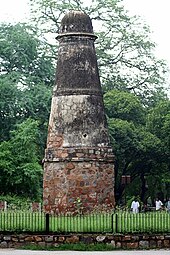
Back Kos-Minar German कोस मीनार Hindi Kosz mínár Hungarian Kos Minar Dutch ਕੋਸ ਮੀਨਾਰ Punjabi کوس مینار PNB โกสมีนาร์ Thai کوس مینار Urdu



The Kos Minars (translated: Mile Pillars) are medieval Indian milestones along the Grand Trunk Road in northern Indian subcontinent, that were introduced by the 16th-century Pashtun ruler Sher Shah Suri. Kos Minars were erected to serve as markers of distance along royal routes from Agra to Ajmer, Agra to Lahore, and from Agra to Mandu in the south.
Most of the Kos Minars are present in Uttar Pradesh, Rajasthan, Haryana, and Punjab by the roadsides, railway tracks, paddy fields and in many towns and villages.[1]
Kos Minars were described as a "marvel of India" by early European travellers such as Sir Thomas Roe and have been labeled as an integral part of India's ''national communication system" by Archaeological Survey of India.[2]
- ^ Gopinath, P. Krishna (12 June 2020). "Kos minars: Pillars of the past". @businessline. Retrieved 27 September 2021.
- ^ "Sher Shah Suri's kos minars once meant to show way to travellers stand lost today - Times of India". The Times of India. 27 January 2018. Retrieved 21 December 2018.
© MMXXIII Rich X Search. We shall prevail. All rights reserved. Rich X Search